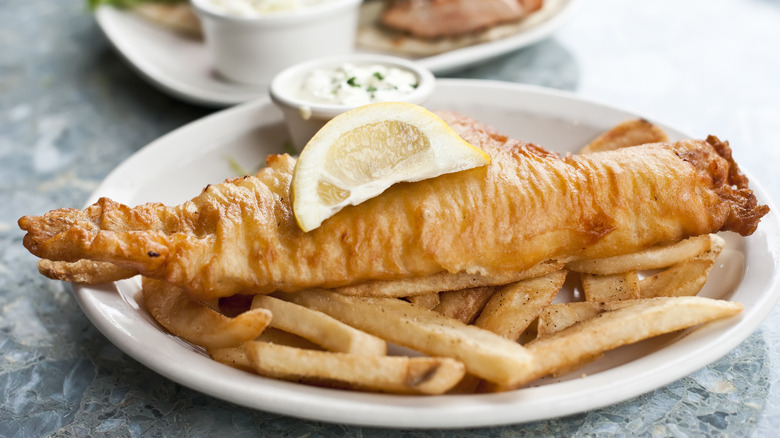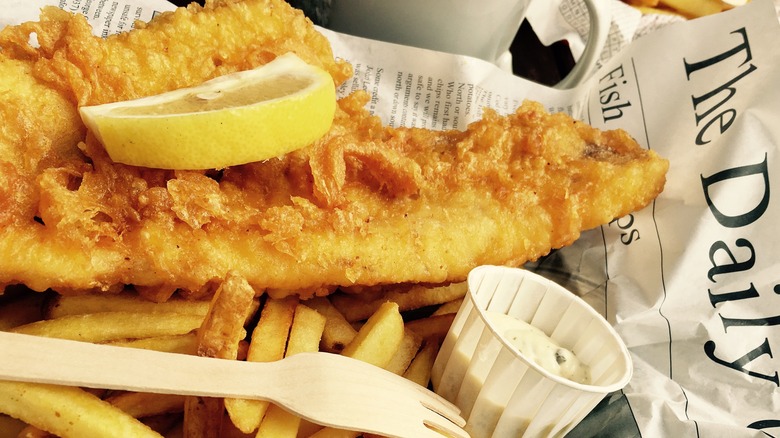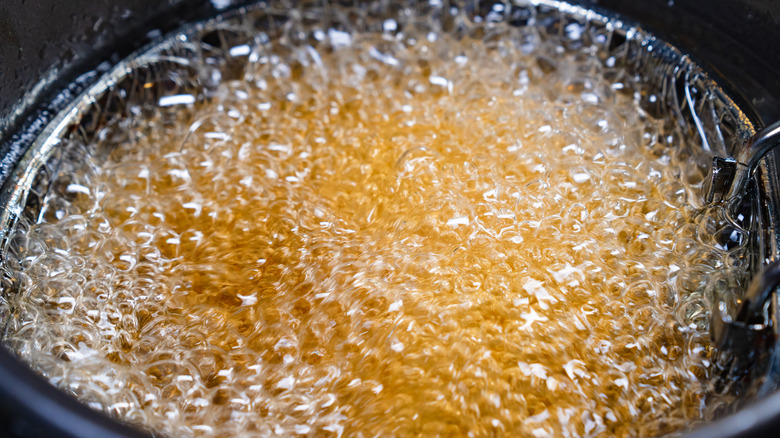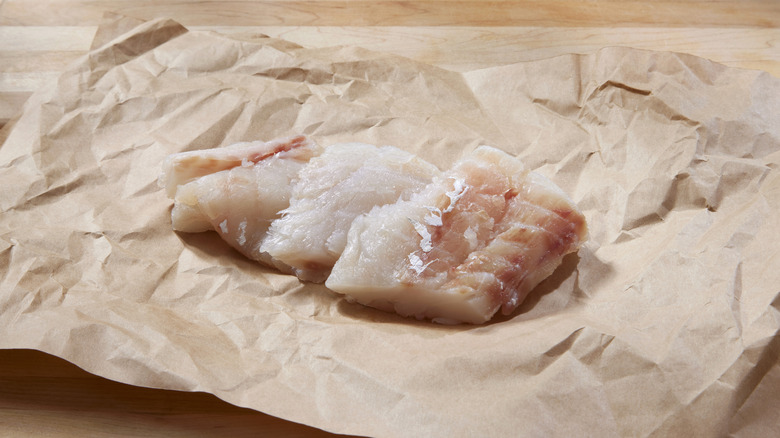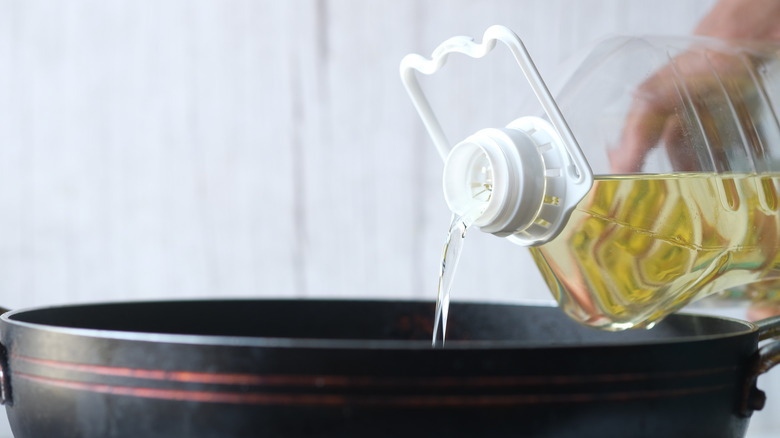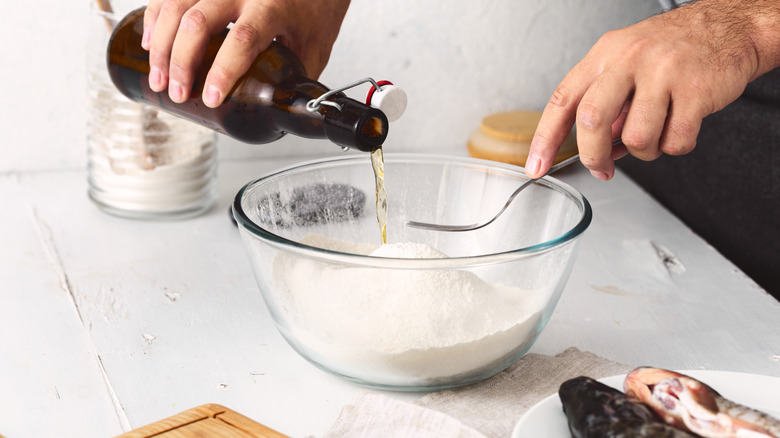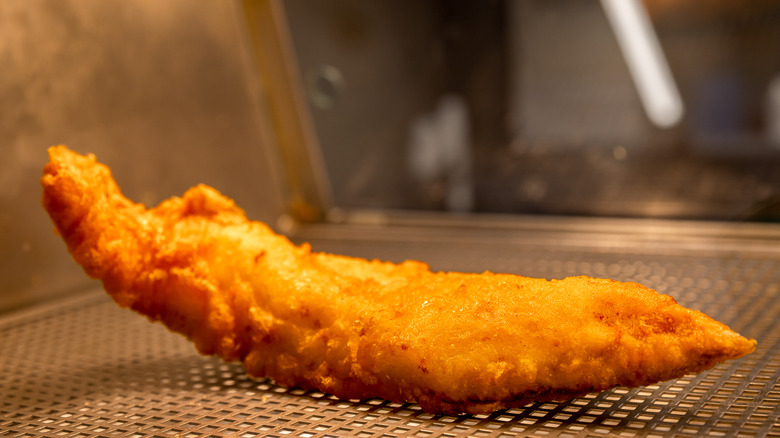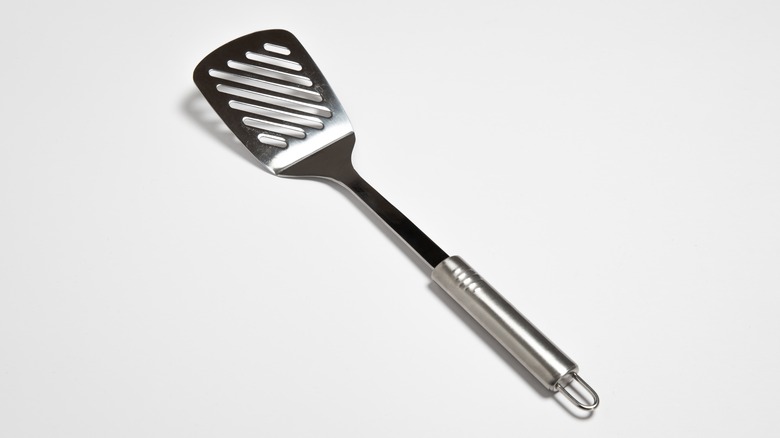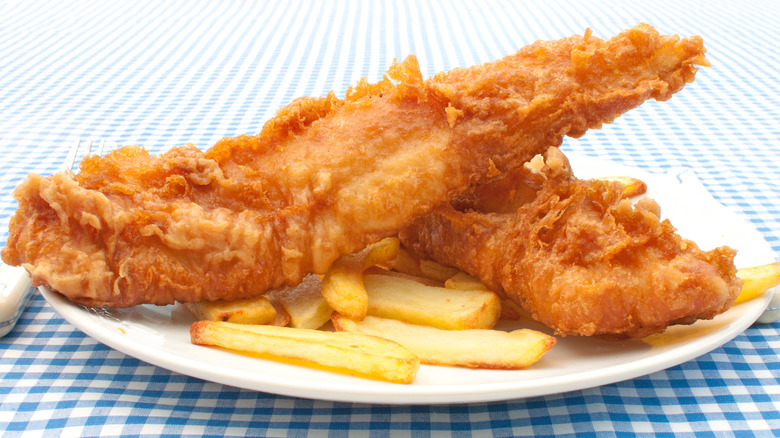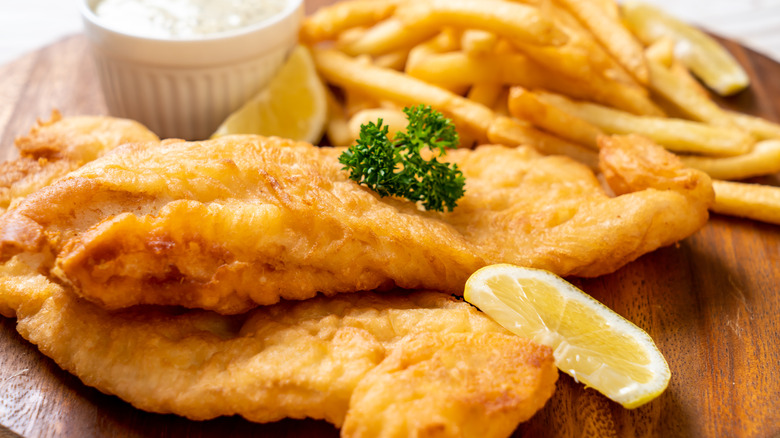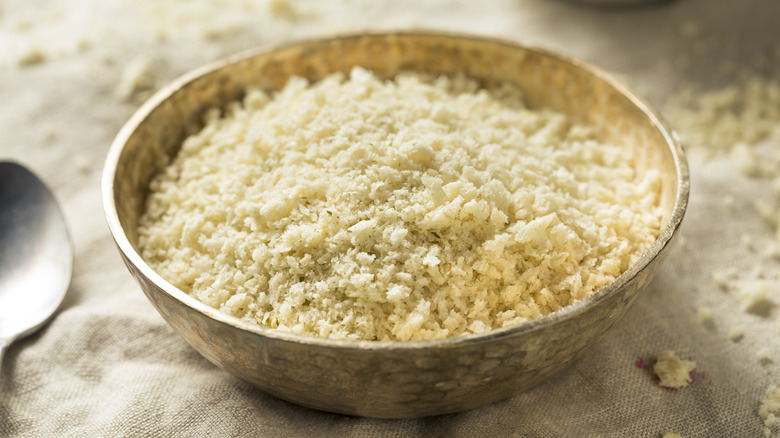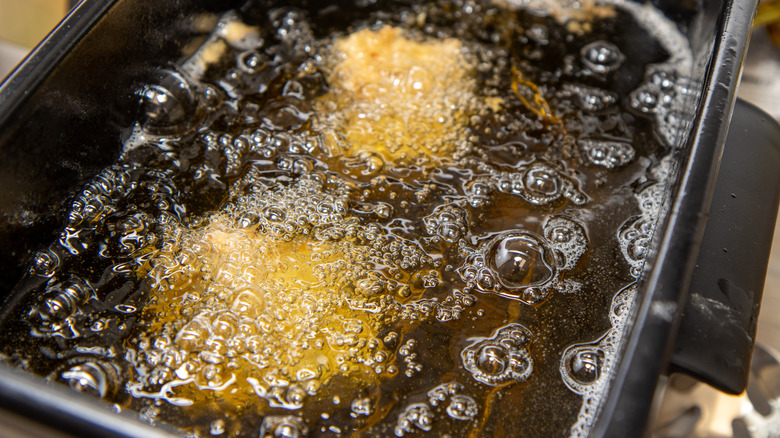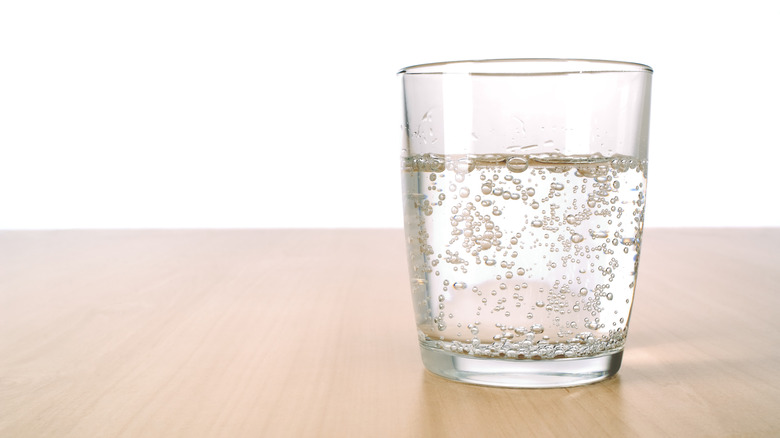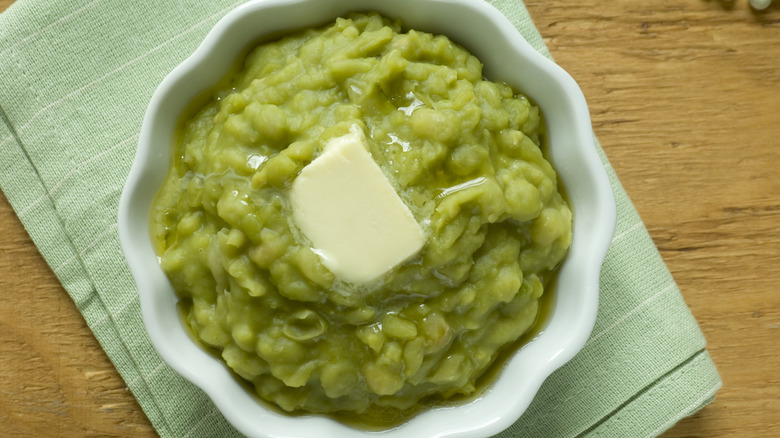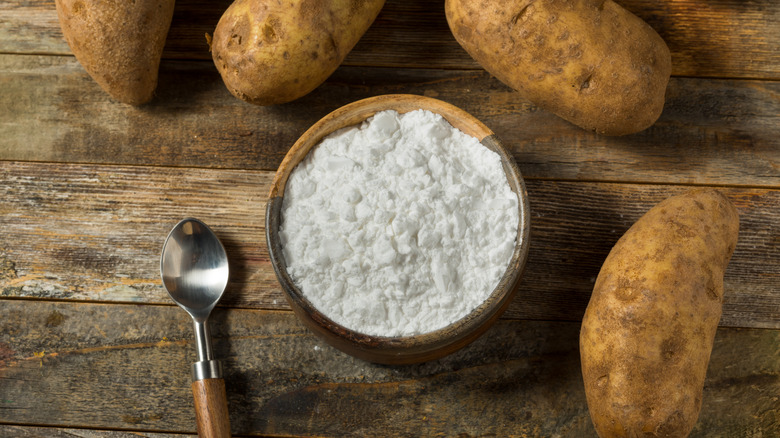14 Tips To Make Your Homemade Fried Fish Pub-Worthy
Every country has a national meal; for the United Kingdom, that meal is fish and chips. The classic combination of deep-fried battered fish and chunky, vinegar-soaked chips is available in every town around the country, both in local chip shops and pub menus. Fish and chips started to become popular during the 19th century in Britain, and the ready availability of fish to the island nation was a big factor in its ubiquitous nature. By the Second World War, when fish and chips were exempt from rationing, it had become one of the most beloved meals around.
The meal and the unique preparation of its main protein soon spread around the globe, and these days, it's fairly easy to find excellent fried fish wherever there's a pub. But what about making it at home? The secrets to making the best-fried fish are closely guarded and rely on the perfect execution of a few key elements. As well as getting the batter right, the fish must be fried at the perfect temperature and using the right equipment. As well as this, fried fish benefits enormously from a few top-secret ingredients, which might be easier to find than you think.
1. Nail your batter
The batter is arguably the most important thing when it comes to pub-worthy fried fish. Coating the fish in the batter gives it a crispy, golden-brown exterior that's perfectly equipped to take on seasonings, and it also stops the fish from becoming dry or overcooked or falling apart in the fat.
To make a proper fish batter, you'll need a few basic elements, the first being flour. You can use plain or self-raising flour, but remember that the former can make the batter too dense. Self-raising flour, on the other hand, will keep it light and airy, ultimately making your fish more crispy. Plain flour can be made lighter by adding a pinch of baking powder.
You'll then need a liquid to mix the flour with. Regular water will work fine, although adding beer or soda water can give it extra aeration and flavor, and milk can also be added to give it a little creaminess. Make sure you add seasoning, too, with a good pinch of salt. This batter for fried fish should be fairly thick, so aim for a 1:1 ratio of flour to liquid. Ensure that you beat it thoroughly so that there are no lumps throughout. Your fish should be fully coated on every side, with no flesh visible when you fry it.
2. Pick your oil wisely
Oils can vary significantly in composition, and not all are well-suited for frying fish. The best ones have a high enough smoke point to ensure that they don't start to become unstable at high temperatures, which can risk making your food taste horribly bitter. As the ideal temperature for deep-frying fish is between 350-375 degrees Fahrenheit, try to pick an oil that will remain stable slightly beyond that to ensure a margin for error.
Many fish and chip shops in the United Kingdom use palm oil, which is prized for its high smoke point and robustness, being able to be used multiple times without reducing in quality. If you're using palm oil, it's vital to buy it from a sustainable source, as the farming of the oil has traditionally had a hugely negative environmental impact. You can also use any other refined oil, like vegetable, soybean, or safflower. However, peanut and canola oils may be the best choice, as they tend to remain the most stable when heated to high temperatures. And whatever you do, don't use that fancy extra-virgin olive oil you have in your cupboard. Not only will it be a waste of money, but it will also release huge amounts of smoke, ruining your fish.
3. Choose the right type of fish
You can make fried fish using many different types of easy-to-find seafood. But if you want to make your fish pub-style, you must go for the classic choices. British fish and chips are pretty much always made with white fish like cod, haddock, or pollock. Cod is the traditional choice, thanks to its flakiness and gentle taste, which pairs beautifully with stronger flavor elements like salt and vinegar. Make sure you're buying Marine Stewardship Council-certified cod to ensure that it's from a sustainable pathway and avoid Atlantic cod if you can, as it's frequently overfished, according to Seafood Watch.
Haddock can have denser flesh than cod, but it also supplies a bit more bang for your buck, flavor-wise. This fish has a sweetness that offers a good contrast to salt and acid. Pollock is slightly fattier than the other two fish and, therefore, can have a more forthright flavor, but it's still subtle enough not to overpower when fried. You can, of course, use any other fish you'd like, with catfish being another good choice. Just bear in mind that alternative types of fish may give a different flavor and alter the profile of the meal.
4. Make sure your oil is the right temperature
It's not enough to throw fish into your oil and hope for the best. The temperature needs to be just right to make your fried fish the best it can be. Your oil should be between 350 to 375 degrees Fahrenheit for the fish to fry effectively. Any colder than that, your fish will become bogged down in the oil, absorbing too much of it and ending up greasy. Any hotter, however, and it will burn on the outside before it has a chance to cook through.
There are a few ways to check if your oil is hot enough before frying. One quick method is to dip the end of a wooden spoon into it. If it starts bubbling, the oil is hot enough. However, If it releases smoke, it's overheated and must be turned down. You can also take a small portion of the batter you've used to coat your fish and drop it into the oil – if it starts to bubble and cook without spitting or smoking, it should be ready.
Truthfully, using a cooking thermometer is the most failsafe way of checking if oil is at the right temperature. These pieces of equipment are rarely expensive and will give the most accurate read possible.
5. Hit your batter with some beer
Although fish batter requires, in theory, little more than flour and liquid, your liquid choice matters. Water will moisten the flour effectively, but it will do nothing in terms of adding flavor and may leave the batter flat and chewy. But real fried fish pros know that using beer is the way to go. Beer has a few components that make it uniquely useful for frying fish, the first being its CO2 content. This CO2 provides bubbles and froths when the fish hits the hot oil, putting up the batter and making it light and tender while simultaneously protecting the fish inside.
Beer is also aided by its yeast, which gives the fish a pleasing, malty flavor while also helping the batter stay airy. As well as this, the alcohol content in beer plays a vital part in the fish's frying. Because of its faster evaporation, the alcohol leaves the batter structure faster, which then dries it out quicker than if you were to use water — and ultimately results in the batter being crispy and the fish remaining tender. This also means there's no risk of the alcohol remaining in the batter and making you drunk.
6. Give your fish enough space
Overcrowding food when it's being fried is a surefire way to ruin it — and it's no different for fried fish. By placing multiple pieces of fried fish in a deep-fryer or pot that's too small, you end up lowering the temperature of the oil. This can reduce it to the point where your fish won't cook. You also run the risk of the oil not being able to get around your fish properly to cook it from all sides and of your fish sticking together in the fryer.
The key is to cook fish fillets one at a time if possible, or a few at a time if you have enough space or they're small enough. Keep an eye on your oil's temperature as you add the food using a thermometer, and if it starts to drop lower than 350 degrees Fahrenheit, resist adding any more. Avoid trying to cook anything else with your fish, too, as additional food items in the oil will alter its taste. If you need to keep your fish fillets warm while you cook the rest, pop them on a wire rack and place them in a preheated oven. The rack will allow any excess fat to drain away and stop the fish from getting soggy.
7. Use the right utensils when cooking
While the main emphasis when cooking fish should be on your recipe and technique, you'll also need to consider your cooking equipment. Never use your hands to place your fish into the oil, as this may result in you scalding your fingers, as advised by 360 Training. Instead, use something with an extended handle to transfer the food in and out of the fryer. Avoid using tongs wherever possible — although they can grab your fish easily, they also smear the batter off, and it ends up glued to the utensil. This leaves you with inadequate coverage of your fish, exposing its flesh. To take the fish out, use a slotted spatula, which allows the oil to drain away and back into the pot.
Speaking of pots, you'll want to use a high-sided, heavy-bottomed vessel if you don't have a deep-fat fryer at home. Ceramic or cast-iron crockpots are good choices, as they have enough volume for the fish to move around while it fries and retains heat well. Using a pan that's too shallow will cause the fat to spit and spill everywhere. This is particularly risky when you're placing your fish into the oil, as it can sometimes bubble up at this point.
8. Make sure you're using the right fillet
When it comes to fried fish, size is everything. You can use any size fish fillet you like, including tiny chunks of fillet to make fish nuggets — but if you want pub-style fried fish, you'll need a fairly big piece to work with. A good rule of thumb is to make sure that your fish fillets are at least 10 centimeters long and 3-4 centimeters wide. This is a good enough size to provide a hearty meal at the end of things.
It's important to try and use fillets that are as uniform in size as possible, with an even thickness all the way through. This will help the fish cook regularly and remain moist throughout. Larger pieces of fish can be used, but make sure they can fit in your pot with enough space to move around. If you're in doubt, it's always better to ask a fishmonger if they can cut a fillet to size for you than to try and guess the size of one in the store. Using a fishmonger will also ensure that you're able to assess the fish you're buying properly and ask about its origins and freshness.
9. Give your fish a whack
Frying fish takes a lot of oil, and if you're not careful, a lot of it ends up on your plate, making your meal greasy and unappetizing. This can occur for several reasons. The first is if you're taking your fish directly from the fat and plating it up, which can allow the excess fat to continue draining off while you're starting to eat. The second is if you decant the fish onto a flat surface, which captures the oil and leaves the fish bathing in it.
But our top tip is to give your fish a whack. After removing your fish from the deep fat fryer, place it in a wire basket or on a wire rack, and bang the container a few times, ideally over the sink, to avoid any spillages. The banging motion will shake the excess fat off the surface of the fish before it has a chance to absorb into the batter. This technique may seem strange, but it can considerably reduce the fat on your fish and ensure that your fish is crispy and not claggy. Decaying your fish onto some paper towel or dabbing it lightly before serving to take any additional fat off the batter's edge may also be helpful.
10. Consider a coating of Panko
When cooked right, a fish coated in batter is crispy, light on the outside, and moist inside. But regular batter can have a tendency to turn out dense and chewy and become weighed down with oil. So, to ensure maximum crispiness, try using Panko breadcrumbs instead of batter to coat your fish. Panko breadcrumbs are extra-dry morsels of bread that have been dehydrated and baked before being bagged and sold. This drying-out process makes them crunchier than other types of breadcrumbs.
Their unique shape also delivers superior crispiness, with a flaky, slightly jagged composition that creates a larger surface area on your food for the oil to access. It's best not to use Panko on top of the batter, as the moistness of the batter and the thick coating it creates will soften the breadcrumbs and make the fish taste too doughy. Instead, light coat your fish fillets with an egg wash before coating them with Panko. Mix salt and pepper with the breadcrumbs to add extra flavor before using them. You'll know the fish is done when the breadcrumb coating reaches a golden-brown color, but make sure you keep an eye on your fillets: Panko can burn fairly easily.
11. Make sure your timings are right
As well as making sure your ingredients are on-point for the best-fried fish, you'll need to make sure your timings are too. Fried fish can be ruined by leaving it in the oil for too long, and doing so will cause the batter and fish to overcook. This will make the fish inside dry and tough and the batter dark and hard. Undercooking it, however, can also be an issue, leaving your fish partially raw and the batter flabby and pale.
The solution to these potential issues is to keep an eye on the time. The average-sized fillet will take around 5 minutes on each side, although it could take slightly less time if your oil is hotter or slightly longer if you're using particularly big pieces. As the fish will float to the surface as it's cooked, you'll need to make sure you're flipping it halfway through cooking. Your fish needs to reach an internal temperature of 145 degrees Fahrenheit to be fully cooked. If you're concerned that you need to cook it for longer, pierce the thickest part of the fillet with a food thermometer to check if it's reached that temperature.
12. A dash of club soda makes all the difference
To ensure your batter is tender, finding ways to get air into it is of paramount importance. But while beer is a common choice, it may not be the best choice for everyone, and there's no denying that it can give the fried fish a slightly hoppy flavor that can be distracting. Pulling out the club soda can be a great alternative. This carbonated water infuses the batter with air bubbles, which expand when heated in the oil, giving the fish's coating way more crunch.
To make sure the club soda does this, it's important to mix it in at the very last moment and not leave the batter standing around for too long. If you do, the bubbles will all dissipate, and the batter will become flat. If you don't have club soda, you can substitute any other sparkling water you have, like seltzer or natural sparkling mineral water. It's best to avoid using flavored water like tonic water because it will make your batter taste bitter and strange.
13. Serve it with some classic sides
Fried fish is nothing without its sides. And to make a pub-style meal out of things, it's best to keep things classic. Pub-style fish and chips are usually served with fat, chunky fries, which tend to be slightly less crispy than the fries served in fast food restaurants. Cut some regular potatoes into roughly two to three centimeters thick rectangles, and deep fry them alongside your fish. The chips should be crispy on the outside but fluffy and soft on the inside. Douse them liberally with malt vinegar and serve them with a good sprinkling of salt.
If you really want to keep things British, whip up a side of mushy peas or curry sauce. Both of these are commonly ordered alongside fish and chips in the country, and each acts as a counterpoint to the crunchy fish and salty fries. Mushy peas are made by puréeing cooked peas until they're a chunky paste. Seasonings like mint and lemon juice are often added to brighten the dish. On the other hand, Curry sauce is a fragrant, spicy sauce, usually thickened with flour or cornstarch and flavored with curry powder, turmeric, garlic, ginger, and onion. While it might not be for everyone, it brings some much-needed complexity and spice to the sometimes-bland meal.
14. Add a secret starch to your batter
Fish batter is traditionally made using regular flour, but that doesn't mean that's the only dry ingredient you can use. And adding a secret starch instead, like potato starch, is a great way to create additional crunch and lightness. Potato starch is commonly used to make Korean-style fried chicken and can be used to coat pretty much any protein, including fish. While flour is good at creating a crispy coating, potato starch excels because of its higher amount of amylose and amylopectin, two molecules that create crunch when cooked. As well as this, potato starch has larger granules than either flour or cornstarch, which gives the oil more to grab onto and which boosts the crunch factor.
Potato starch doesn't taste like potato, either: It's pretty much flavorless, so it won't give your fish any unwanted tastes. Remember that if you don't want to use potato starch, you can try using a mix of the starch and regular, all-purpose flour. If it's difficult to find potato starch at the grocery store, you can substitute it for cornstarch.
